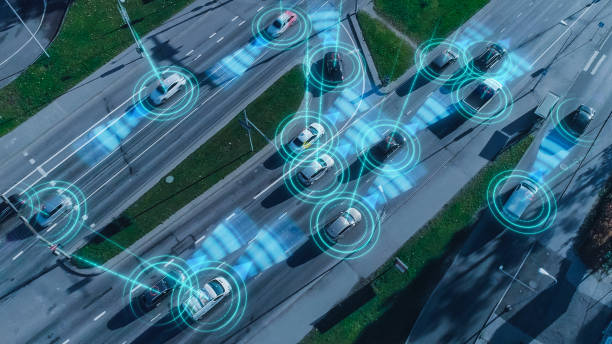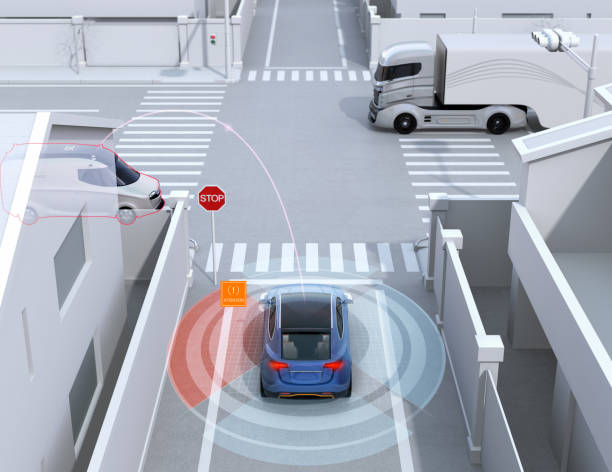Introduction
The global transportation landscape is undergoing a paradigm shift, with sustainable solutions emerging as a critical priority. Among these, autonomous vehicles have garnered significant attention for their potential to revolutionize transportation, offering a greener, safer, and more efficient alternative. However, the journey towards achieving sustainable transportation through autonomous vehicles is fraught with challenges, especially concerning patents and intellectual property. In this comprehensive exploration, we delve into the complex world of patent challenges that surround the development and deployment of autonomous vehicles within the context of sustainable transportation.

Understanding Autonomous Vehicles in Sustainable Transportation
Autonomous vehicles, also known as self-driving cars, represent a revolutionary advancement in the realm of sustainable transportation. These vehicles are equipped with cutting-edge technologies that enable them to operate without human intervention, relying on an array of sensors, cameras, GPS, and sophisticated algorithms to perceive their surroundings and navigate the roads. The integration of autonomous vehicles into sustainable transportation systems holds the potential to address several critical challenges facing modern society, including environmental degradation, traffic congestion, and energy consumption.
Sustainability is a central tenet of the autonomous vehicle paradigm, as these vehicles offer a multitude of benefits that contribute to a greener and more efficient transportation ecosystem. First and foremost, autonomous vehicles have the capacity to significantly reduce carbon emissions and the overall environmental footprint of the transportation sector. By employing advanced navigation systems and predictive analytics, autonomous vehicles can optimize driving routes, minimize idle time, and maximize fuel efficiency, thereby reducing the release of harmful greenhouse gases.
Moreover, the introduction of autonomous vehicles has the potential to revolutionize the concept of shared mobility and public transportation. The implementation of autonomous fleets for ride-sharing services and public transit can enhance the accessibility and affordability of transportation, thereby reducing the dependency on individual car ownership and promoting a more sustainable mode of mobility. This shift towards shared autonomous transportation not only alleviates traffic congestion but also contributes to a reduction in the demand for parking spaces, subsequently freeing up urban areas for green spaces and pedestrian zones.
Furthermore, the integration of autonomous vehicles into sustainable transportation networks can facilitate the seamless integration of electric and alternative fuel technologies. The convergence of autonomous capabilities with electric and hybrid vehicle systems promotes the adoption of cleaner and more energy-efficient modes of transportation, ultimately contributing to the reduction of air pollution and the conservation of natural resources. Autonomous electric vehicles, in particular, offer a compelling solution for achieving sustainable transportation goals by significantly reducing reliance on fossil fuels and promoting the transition towards renewable energy sources.
Additionally, autonomous vehicles are poised to enhance road safety and reduce the frequency of accidents, thereby promoting a safer and more sustainable transportation environment. By leveraging real-time data and predictive analytics, autonomous vehicles can anticipate potential hazards, mitigate risks, and adhere to traffic regulations, significantly lowering the incidence of human error-related accidents. This enhanced safety profile not only safeguards human lives but also minimizes the environmental and economic costs associated with road accidents, including the consumption of resources for emergency response and the production of vehicle components.
In essence, autonomous vehicles serve as a pivotal catalyst for the transformation of the transportation sector, offering a comprehensive and sustainable solution to the multifaceted challenges facing modern society. By embracing the principles of environmental responsibility, resource efficiency, and enhanced safety, autonomous vehicles are poised to redefine the future of sustainable transportation, ushering in an era of interconnected, eco-friendly, and technologically advanced mobility systems that benefit both individuals and the planet as a whole.
The Role of Patents in Autonomous Vehicle Innovation
Patents play a fundamental role in fostering and protecting innovation within the autonomous vehicle industry. These legal instruments provide inventors and companies with exclusive rights to their inventions, thereby incentivizing investment in research and development and facilitating the commercialization of groundbreaking technologies. In the context of autonomous vehicles, patents serve several crucial functions that are integral to the advancement of innovation and the proliferation of cutting-edge transportation technologies.
1. Encouraging Research and Development
Patents incentivize research and development efforts by granting inventors exclusive rights to their innovations for a specified period. This exclusivity allows companies to recoup their investment in developing autonomous vehicle technologies, thereby encouraging continuous exploration and refinement of novel concepts and solutions. The promise of securing patents motivates researchers and engineers to push the boundaries of technological capabilities, leading to the creation of advanced sensors, algorithms, and computing systems that underpin autonomous vehicle operations.
2. Protection of Intellectual Property
Patents provide legal protection for the intellectual property rights associated with autonomous vehicle innovations. By securing patents for proprietary technologies, companies can safeguard their research findings and technological advancements from unauthorized use, reproduction, or exploitation by competitors. This protection encourages a conducive environment for open innovation, enabling companies to share their knowledge and collaborate with other industry players without the fear of intellectual property theft or infringement.
3. Promotion of Technological Integration
Patents facilitate the integration of diverse technologies within the autonomous vehicle ecosystem. As companies secure patents for specific components, software algorithms, or hardware systems, they contribute to the development of an extensive technological infrastructure that supports the seamless operation of autonomous vehicles. This integration fosters the convergence of disciplines such as artificial intelligence, sensor technology, and communication systems, enabling the creation of sophisticated autonomous driving systems that enhance vehicle safety, navigation, and performance.
4. Stimulating Market Competition
While patents grant exclusive rights to inventors, they also foster healthy market competition by encouraging companies to innovate and differentiate their offerings. By promoting a competitive landscape, patents incentivize companies to continuously improve their autonomous vehicle technologies, driving the industry towards greater innovation and the development of more efficient and reliable transportation solutions. This competitive environment not only benefits consumers by offering a diverse range of autonomous vehicle options but also fuels the advancement of sustainable and eco-friendly transportation practices.
5. Support for Licensing and Collaborative Ventures
Patents facilitate licensing agreements and collaborative ventures within the autonomous vehicle industry, enabling companies to leverage each other’s technological advancements and intellectual property for mutual benefit. Through licensing, companies can share their patented technologies with other industry players, promoting the widespread adoption of standardized systems and fostering interoperability among autonomous vehicles. Collaborative ventures, enabled by cross-licensing agreements, encourage knowledge sharing and the collective development of comprehensive autonomous vehicle solutions, thereby accelerating the pace of innovation and the realization of sustainable transportation goals.
In summary, patents serve as a cornerstone of autonomous vehicle innovation, providing the necessary incentives, protection, and collaborative frameworks that drive the development and commercialization of advanced technologies within the transportation sector. By fostering a dynamic and competitive environment, patents contribute to the continual evolution of autonomous vehicle capabilities, paving the way for a future of enhanced mobility, safety, and sustainability.

Patent Challenges in the Autonomous Vehicle Sector
The development and implementation of autonomous vehicles are significantly influenced by complex patent challenges, presenting a multitude of obstacles within the sector. These challenges arise from the intricate and multifaceted nature of autonomous vehicle technology, leading to various legal and technological complications that hinder innovation and progress in the field. Several key challenges dominate the patent landscape in the autonomous vehicle sector:
1. Complex Patent Landscapes
The autonomous vehicle industry is characterized by a dense web of patents held by numerous stakeholders, including established technology firms, automotive manufacturers, and emerging startups. The intricate and overlapping nature of these patents often leads to legal disputes and hampers the pace of innovation. Navigating this complex patent landscape poses a significant challenge for companies striving to develop and integrate sustainable transportation solutions, ultimately impeding the seamless advancement of autonomous vehicle technology.
2. Lack of Interoperability
The lack of standardized protocols and interoperability among different autonomous vehicle systems exacerbates the challenges within the sector. Varied proprietary technologies and incompatible systems often result in patent disputes and hinder collaborative efforts among industry players. The absence of unified standards not only complicates the integration of sustainable practices but also impedes the establishment of a cohesive and interconnected autonomous transportation network, thereby slowing down the overall progress in achieving sustainable transportation goals.
3. Legal Ambiguities
The evolving nature of autonomous vehicle technology poses significant challenges in interpreting and enforcing patent laws. Ambiguities within existing intellectual property regulations, particularly in relation to emerging technologies, contribute to legal uncertainties and protracted litigation. The lack of clarity in patent claims, coupled with the absence of specific regulations tailored to autonomous transportation technologies, leads to prolonged legal battles, creating significant barriers to the development and deployment of sustainable autonomous vehicle solutions.
4. Market Monopolization
The accumulation of patents by dominant players in the autonomous vehicle sector can potentially result in market monopolization, limiting the entry of smaller companies and startups. This monopoly restricts access to critical technologies and hampers the integration of sustainable transportation solutions. Moreover, market monopolization stifles competition and innovation, leading to an environment that is less conducive to the widespread adoption of autonomous vehicle technology and sustainable transportation practices.
5. Cybersecurity and Data Privacy Concerns
The proliferation of patents in autonomous vehicle technology raises significant cybersecurity and data privacy concerns. As the industry relies heavily on interconnected systems and real-time data processing, the protection of sensitive information and the prevention of cyber threats become paramount. Patent challenges related to cybersecurity and data privacy necessitate the development of robust and comprehensive strategies that safeguard autonomous vehicle technologies from potential security breaches and unauthorized data access, ensuring the integrity and trustworthiness of these advanced transportation systems.
Addressing these patent challenges requires collaborative efforts from industry stakeholders, policymakers, and regulatory bodies. Implementing standardized protocols, fostering legal clarity, promoting fair competition, and prioritizing data security measures are imperative steps toward establishing a conducive environment for innovation and sustainable development within the autonomous vehicle sector. By proactively addressing these challenges, the industry can pave the way for a more transparent, collaborative, and sustainable future of autonomous transportation.

Overcoming Patent Challenges for Sustainable Autonomous Transportation
Overcoming the patent challenges within the autonomous vehicle sector is crucial for fostering sustainable transportation solutions. Addressing these challenges requires a multifaceted approach that prioritizes collaboration, legislative reforms, and the establishment of robust partnerships. By implementing the following strategies, stakeholders can create an environment conducive to the development and deployment of sustainable autonomous transportation:
1. Collaboration and Standardization
Encouraging collaboration among industry stakeholders and fostering the development of standardized protocols is essential for overcoming patent-related disputes. Establishing open standards and protocols that promote interoperability and data sharing facilitates a more inclusive and collaborative environment. This, in turn, allows for the seamless integration of sustainable practices across various autonomous transportation systems, fostering a cohesive and interconnected network.
2. Legislative Reforms and Policy Frameworks
Implementing comprehensive legislative reforms and policy frameworks tailored to the unique challenges of autonomous vehicle technology is critical. Clear guidelines for patent applications, licensing agreements, and dispute resolutions can streamline the development process and encourage sustainable transportation initiatives. By providing legal clarity and predictability, these reforms can foster an environment that encourages innovation, safeguards intellectual property rights, and ensures fair competition within the sector.
3. Patent Pools and Licensing Agreements
Creating patent pools and facilitating cross-licensing agreements among industry players is a proactive step toward overcoming patent-related challenges. By promoting the sharing of intellectual property rights, patent pools and licensing agreements can mitigate the risks of patent disputes and encourage the widespread adoption of environmentally friendly autonomous vehicle technologies. This approach fosters a culture of cooperation and collective innovation, enabling stakeholders to work together towards common sustainable transportation goals.
4. Public-Private Partnerships
Establishing robust public-private partnerships that facilitate knowledge exchange and collaborative research initiatives can accelerate the development of sustainable autonomous transportation solutions. These partnerships create an ecosystem of shared expertise and resources, enabling stakeholders to leverage each other’s strengths and capabilities. By fostering an environment of collaboration and collective problem-solving, public-private partnerships contribute to the integration of sustainable practices, driving the widespread adoption of autonomous vehicles that contribute to a greener and more sustainable transportation ecosystem.
5. Investment in Cybersecurity and Data Privacy
Prioritizing investment in robust cybersecurity and data privacy measures is crucial to addressing the concerns associated with patent challenges. Establishing comprehensive data protection protocols and implementing state-of-the-art cybersecurity measures can safeguard autonomous vehicle technologies from potential security breaches and data privacy violations. By prioritizing data security, stakeholders can build trust and confidence in the autonomous transportation ecosystem, ensuring the integrity and reliability of these advanced technologies.
By implementing these strategies, stakeholders within the autonomous vehicle sector can work towards creating an inclusive, innovative, and sustainable environment that fosters the development and deployment of autonomous transportation solutions. These collective efforts will contribute to the realization of a future where sustainable autonomous transportation plays a pivotal role in addressing the global challenges of climate change, urbanization, and transportation efficiency.
Conclusion
The journey towards achieving sustainable transportation through autonomous vehicles is intrinsically linked with the resolution of patent-related challenges. While these challenges may seem daunting, they present an opportunity for industry stakeholders, policymakers, and innovators to collaborate and establish a more conducive environment for the development and deployment of sustainable autonomous transportation solutions. By prioritizing collaboration, standardization, legislative reforms, and public-private partnerships, the autonomous vehicle sector can overcome patent-related barriers and pave the way for a more sustainable and interconnected transportation ecosystem that benefits society, the environment, and future generations.

